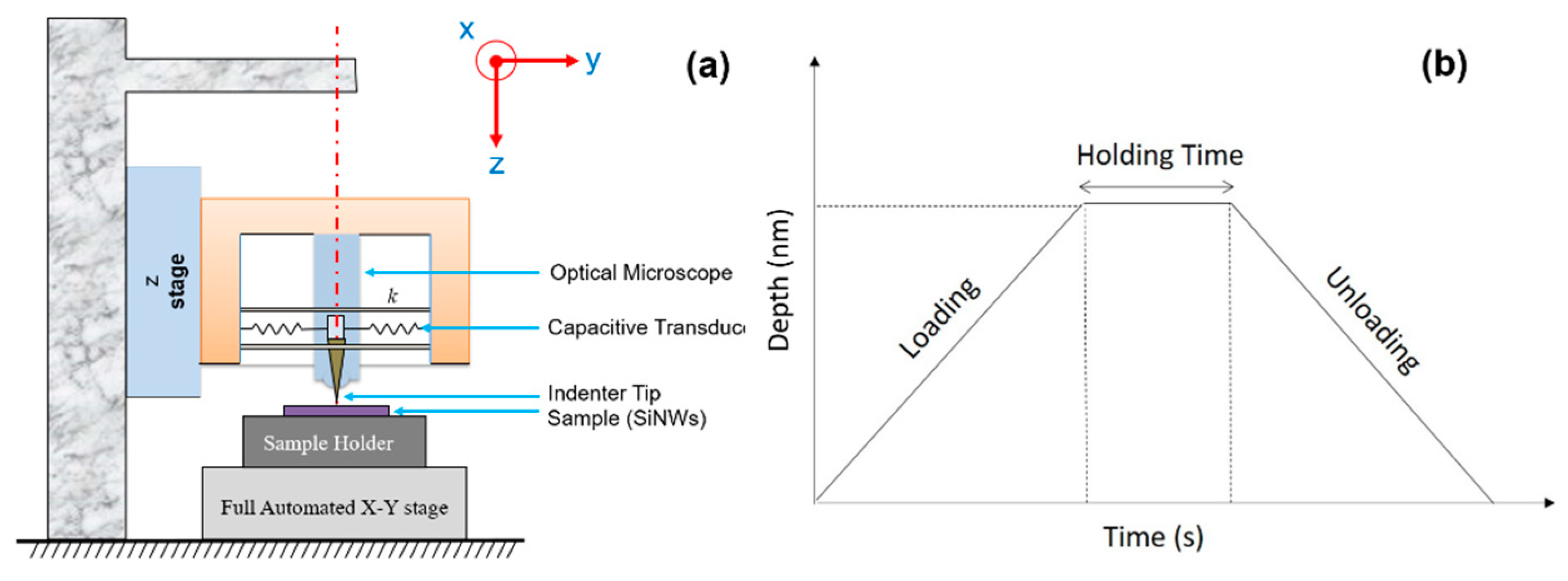Nanomechanical Traceable Metrology of Vertically Aligned Silicon and Germanium Nanowires by Nanoindentation
Abstract
:1. Introduction
2. Fabrication of Vertical Nanowires
3. Nanomechanical Characterization
4. Results and Discussion
Author Contributions
Acknowledgments
Conflicts of Interest
References
- Oliver, W.C.; Pharr, G.M. Measurement of hardness and elastic modulus by instrumented indentation: Advances in understanding and refinements to methodology. J. Mater. Res. 2004, 19, 3–20. [Google Scholar] [CrossRef]
- Hamdana, G.; Bertke, M.; Doering, L.; Frank, T.; Brand, U.; Wasisto, H.S.; Peiner, E. Transferable Micromachined Piezoresistive Force Sensor with Integrated Double-Meander-Spring System. J. Sens. Sens. Syst. 2017, 6, 121–133. [Google Scholar] [CrossRef]
- Kim, M.S.; Pratt, J.R. SI traceability: Current status and future trends for forces below 10 microNewtons. Meas. J. Int. Meas. Confed. 2010, 43, 169–182. [Google Scholar] [CrossRef]
- Li, Z.; Gao, S.; Polenz, F.; Brand, U.; Koenders, L.; Peiner, E. Determination of the mechanical properties of nano-pillars using the nanoindentation technique. Nanotechnol. Precis. Eng. 2014, 3, 182–188. [Google Scholar]
- Datye, A.; Li, L.; Zhang, W.; Wei, Y.; Gao, Y.; Pharr, G.M. Extraction of Anisotropic Mechanical Properties From Nanoindentation of SiC-6H Single Crystals. J. Appl. Mech. 2016, 83, 91003. [Google Scholar] [CrossRef]
- Fujisawa, N.; Ogura, T.; Hirose, A. A Method for Studying the Nano-Scale Stress-Strain Response of a Material by Nanoindentation. Mater. Trans. 2016, 57, 1006–1009. [Google Scholar] [CrossRef]
- Hamdana, G.; Südkamp, T.; Descoins, M.; Mangelinck, D.; Caccamo, L.; Bertke, M.; Wasisto, H.S.; Bracht, H.; Peiner, E. Towards Fabrication of 3D Isotopically Modulated Vertical Silicon Nanowires in Selective Areas by Nanosphere Lithography. Microelectron. Eng. 2017, 179, 74–82. [Google Scholar] [CrossRef]
- Merzsch, S.; Steib, F.; Wasisto, H.S.; Stranz, A.; Hinze, P.; Weimann, T.; Peiner, E.; Waag, A. Production of vertical nanowire resonators by cryogenic-ICP-DRIE. Microsyst. Technol. 2014, 20, 759–767. [Google Scholar] [CrossRef]
- Miao, H.; Chen, L.; Mirzaeimoghri, M.; Kasica, R.; Wen, H. Cryogenic Etching of High Aspect Ratio 400-nm Pitch Silicon Gratings. J. Microelectromech. Syst. 2016, 25, 963–967. [Google Scholar] [CrossRef] [PubMed]
- Oliver, W.C.; Pharr, G.M. An improved technique for determining hardness and elastic modulus using load and displacement sensing indentation experiments. J. Mater. Res. 1992, 7, 1564–1583. [Google Scholar] [CrossRef]
- Berkovich, E.S. Three-faceted diamond pyramid for studying microhardness by indentation. Zavod. Lab. 1950, 13, 345–347. [Google Scholar]




Publisher’s Note: MDPI stays neutral with regard to jurisdictional claims in published maps and institutional affiliations. |
© 2017 by the authors. Licensee MDPI, Basel, Switzerland. This article is an open access article distributed under the terms and conditions of the Creative Commons Attribution (CC BY) license (https://creativecommons.org/licenses/by/4.0/).
Share and Cite
Hamdana, G.; Granz, T.; Bertke, M.; Li, Z.; Puranto, P.; Brand, U.; Wasisto, H.S.; Peiner, E. Nanomechanical Traceable Metrology of Vertically Aligned Silicon and Germanium Nanowires by Nanoindentation. Proceedings 2017, 1, 375. https://doi.org/10.3390/proceedings1040375
Hamdana G, Granz T, Bertke M, Li Z, Puranto P, Brand U, Wasisto HS, Peiner E. Nanomechanical Traceable Metrology of Vertically Aligned Silicon and Germanium Nanowires by Nanoindentation. Proceedings. 2017; 1(4):375. https://doi.org/10.3390/proceedings1040375
Chicago/Turabian StyleHamdana, Gerry, Tony Granz, Maik Bertke, Zhi Li, Prabowo Puranto, Uwe Brand, Hutomo Suryo Wasisto, and Erwin Peiner. 2017. "Nanomechanical Traceable Metrology of Vertically Aligned Silicon and Germanium Nanowires by Nanoindentation" Proceedings 1, no. 4: 375. https://doi.org/10.3390/proceedings1040375





